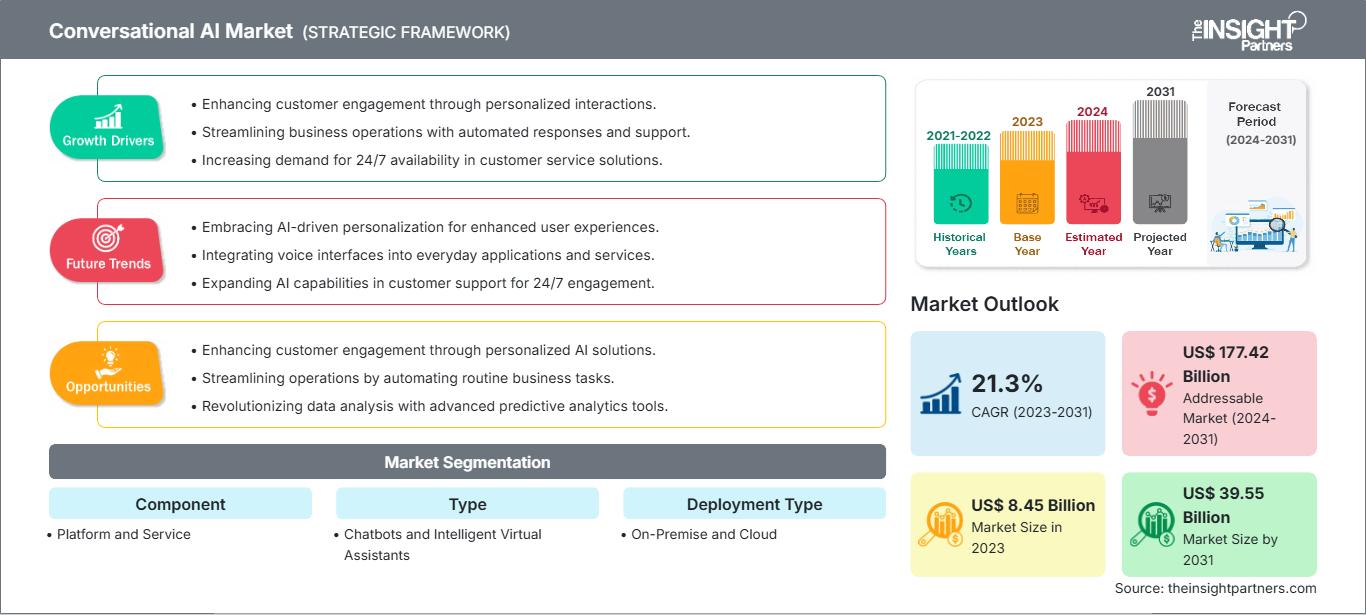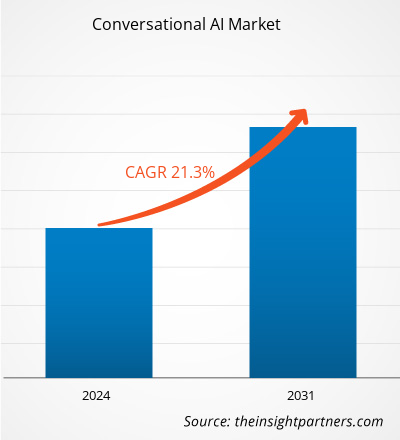The conversational AI market size is expected to reach US$ 39.55 billion by 2031 from US$ 8.45 billion in 2023. The market is estimated to record a CAGR of 21.3% from 2023 to 2031. The growing adoption of conversational AI in the gaming industry is likely to remain a key market trend during the forecast period.
Conversational AI Market Analysis
The rising demand and falling chatbot development costs, AI-powered customer support services, and omnichannel deployment drive the conversational AI market growth. Numerous development projects are in progress to ensure that these technologies are used effectively and efficiently for enterprise use cases that address real business issues. In order to make use of Al's ability to respond in a conversational manner like a human, a number of generative Al companies have emerged. It has the potential to completely change how people interact with technology by facilitating more casual, human-like conversations that are tailored to individual needs and preferences. Furthermore, the use of conversational AI platforms is becoming popular among public sector organizations as governments across the world work to permit widespread digital transformation and reinvent the citizen experience, boosting market growth.
Conversational AI Market Overview
Conversational artificial intelligence (AI) refers to technology that consumers can interact with such as chatbots or virtual agents. They mimic human interactions by identifying speech and text inputs; translating their meanings across several languages; and using massive volumes of data, machine learning (ML), and natural language processing (NLP). Conversational AI mixes NLP and ML techniques with traditional, static types of interactive technology such as chatbots. Through interactions that resemble those with standard human agents, this combination is employed to respond to consumers.
Customize This Report To Suit Your Requirement
You will get customization on any report - free of charge - including parts of this report, or country-level analysis, Excel Data pack, as well as avail great offers and discounts for start-ups & universities
Conversational AI Market: Strategic Insights

-
Get Top Key Market Trends of this report.This FREE sample will include data analysis, ranging from market trends to estimates and forecasts.
Conversational AI Market Drivers and Opportunities
Growing E-commerce Sector Drives Conversational AI Market
Since the COVID-19 pandemic, there has been a surge in online shopping across the world. According to the International Air Transport Association (IATA), in 2021, 2.14 billion people (i.e., ∼27.6% of the world’s population) bought products from online portals. In addition, APAC leads the global e-commerce market, where China accounts for a significant percentage of the regional market growth. As per the International Trade Administration, China is the largest e-commerce market across the world, generating ∼ 50% of the world’s transactions. In 2021, the country generated ∼ US$ 1.5 trillion in revenue through the e-commerce sector, becoming the largest e-commerce market in the world. Also, Europe is a key region supporting e-commerce growth. According to Eurostat, in 2022, 91% of people aged 16–74 years in the European Union (EU) countries used the internet, of which ∼ 75% ordered goods or services online. Also, the proportion of e-shoppers grew to 75% in 2022 from 55% in 2012, an increase of 20% over the last decade. Many shoppers in Europe prefer online shopping platforms such as Amazon, Target, and Walmart, which majorly drives the growth of the e-commerce sector in Europe. The growing demand for online shopping is raising the demand for conversational commerce. The intelligent AI-powered shopping bots are revolutionizing the e-commerce industry by interacting with their customers, providing personalized guidance, and further driving sales. Also, by leveraging machine learning and natural language processing, conversational AI helps engage meaningful dialogues, understand customer needs, and nurture leads in real time. Thus, the growing e-commerce sector propels the conversational AI market growth.
Emergence of Generative AI to Offer Opportunities for Market During Forecast Period
Generative AI is extremely important across a wide range of businesses. Its ability to generate unique content has important ramifications in industries such as art, design, and marketing. This technology improves personalization and innovates and streamlines creative processes. Furthermore, by producing different scenarios and answers, generative AI aids in problem-solving. Thus, it is emerging as a key tool that transforms conventional methodologies and opens up new possibilities as industries try to realize the potential of AI-driven innovation. In addition, generative AI excels in automating repetitive activities, freeing up human resources for more strategic and complicated projects. Also, it provides highly personalized experiences by providing product information to individual tastes. From tailored marketing campaigns to curated product suggestions, generative AI technology uses data to produce content that communicates to each user. Incorporating generative AI into conversational AI chatbots and virtual assistants improves their ability to participate in natural, human-like conversations. These systems interpret and process user input to produce real-time responses, suggestions, and solutions. Generative AI enables chatbots to deliver tailored advice and manage difficult inquiries. This transforms customer service, e-commerce interactions, and other areas where effective communication is critical. Furthermore, generative AI technology is transforming the world of language processing, allowing for accurate translations and natural interactions that cross traditional communication borders. Its applications in language translation and chatbot interactions demonstrate the revolutionary power of cutting-edge AI technology across a wide range of sectors. Thus, the emergence of generative AI is expected to fuel the growth of the conversational AI market during the forecasted period.
Conversational AI Market Report Segmentation Analysis
Key segments that contributed to the derivation of the conversational AI market analysis are component, type, deployment type, and industry.
- Based on component, the market is bifurcated into platform and service. The platform segment dominated the market in 2023.
- Based on type, the market is segmented into chatbots and intelligent virtual assistants. The chatbots segment dominated the market in 2023.
- In terms of deployment type, the conversational AI market is segmented into on-premise and cloud. The on-premise segment dominated the market in 2023.
- Based on industry, the market is segmented into retail & e-commerce, healthcare & life sciences, travel & hospitality, BFSI, IT & telecom, media & entertainment, and others. The retail & e-commerce segment dominated the market in 2023.
Conversational AI Market Share Analysis by Geography
- The conversational AI market is segmented into five major regions—North America, Europe, Asia Pacific (APAC), the Middle East & Africa (MEA), and South & Central America. North America dominated the market in 2023, followed by Europe and APAC.
- North America held the largest market share in 2023. The market in the region is experiencing robust growth owing to the widespread adoption of innovative technologies and the rapidly increasing need for AI-powered customer support services. In addition, the majority of businesses in North America are investing in technology innovations to meet and exceed the needs of their clientele. The increased health consciousness among the population also drives the growth of the conversational AI market in the region. The healthcare industry in North America is leading the way in integrating robotics, AI, virtual reality (VR), and augmented reality (AR).
Conversational AI Market Regional Insights
The regional trends and factors influencing the Conversational AI Market throughout the forecast period have been thoroughly explained by the analysts at The Insight Partners. This section also discusses Conversational AI Market segments and geography across North America, Europe, Asia Pacific, Middle East and Africa, and South and Central America.
Conversational AI Market Report Scope
| Report Attribute | Details |
|---|---|
| Market size in 2023 | US$ 8.45 Billion |
| Market Size by 2031 | US$ 39.55 Billion |
| Global CAGR (2023 - 2031) | 21.3% |
| Historical Data | 2021-2022 |
| Forecast period | 2024-2031 |
| Segments Covered |
By Component
|
| Regions and Countries Covered |
North America
|
| Market leaders and key company profiles |
|
Conversational AI Market Players Density: Understanding Its Impact on Business Dynamics
The Conversational AI Market is growing rapidly, driven by increasing end-user demand due to factors such as evolving consumer preferences, technological advancements, and greater awareness of the product's benefits. As demand rises, businesses are expanding their offerings, innovating to meet consumer needs, and capitalizing on emerging trends, which further fuels market growth.

- Get the Conversational AI Market top key players overview
Conversational AI Market News and Recent Developments
The conversational AI market is evaluated by gathering qualitative and quantitative data post primary and secondary research, which includes important corporate publications, association data, and databases. A few of the developments in the conversational AI market are listed below:
- Amazon.com, Inc. announced the general availability of Amazon Q for businesses and developers. Amazon Q is the most capable generative AI-powered assistant for accelerating software development and leveraging companies’ internal data.
(Source: Amazon, Press Release, April 2024)
- Wipro Limited launched Wipro Enterprise Artificial Intelligence (AI)-Ready Platform by leveraging International Business Machines Corp’s watsonx AI and data platforms, including watsonx.ai, watsonx.data, and watsonx.governance, and AI assistants. This partnership supports Wipro Limited to deliver to clients an interoperable service that helps accelerate AI adoption.
(Source: International Business Machines Corporation, Press Release, February 2024)
Conversational AI Market Report Coverage and Deliverables
The "Conversational AI Market Size and Forecast (2021–2031)" provides a detailed analysis of the market covering the areas mentioned below:
- Cost-estimating software market size and forecast at global, regional, and country levels for all the key market segments covered under the scope
- Cost-estimating software market trends as well as market dynamics such as drivers, restraints, and key opportunities
- Detailed PEST and SWOT analysis
- Cost-estimating software market analysis covering key market trends, global and regional framework, major players, regulations, and recent market developments
- Industry landscape and competition analysis covering market concentration, heat map analysis, prominent players, and recent developments for the conversational AI market
- Detailed company profiles
Frequently Asked Questions
Which is the fastest-growing regional market?
Which are the key players holding the major market share of the conversational AI market?
What will be the market size for the conversational AI market by 2031?
Which country is holding the major market share of the global conversational AI market?
What are the driving factors impacting the conversational AI market?
What is the estimated market size for the conversational AI market in 2023?
What are the future trends of the conversational AI market?
- Historical Analysis (2 Years), Base Year, Forecast (7 Years) with CAGR
- PEST and SWOT Analysis
- Market Size Value / Volume - Global, Regional, Country
- Industry and Competitive Landscape
- Excel Dataset
Recent Reports
Related Reports
Testimonials
Reason to Buy
- Informed Decision-Making
- Understanding Market Dynamics
- Competitive Analysis
- Identifying Emerging Markets
- Customer Insights
- Market Forecasts
- Risk Mitigation
- Boosting Operational Efficiency
- Strategic Planning
- Investment Justification
- Tracking Industry Innovations
- Aligning with Regulatory Trends





















 Get Free Sample For
Get Free Sample For